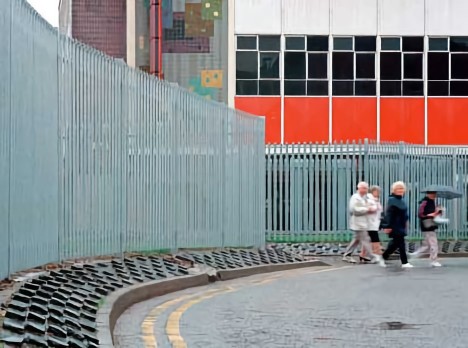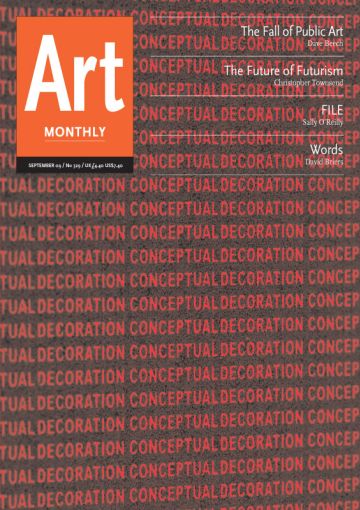Feature
Inside Out
Dave Beech on the fall of public art

Cornford & Cross, Camelot, 1996
On 7 July this year a memorial to the 7/7 bombing victims in London was unveiled in Hyde Park. Designed by two young architects, Kevin Carmody and Andrew Groarke, it consists of 52 stainless steel columns, corresponding to the number of innocents killed in 2005. The commissioning body, bringing together representatives of the Royal Parks, the Department of Culture, Media and Sport and members of six of the bereaved families, selected the project overridingly because of the architects’ commitment to working with the families rather than imposing a design on them. It is difficult to get these negotiations right. In this case, the result is not populist, but professional, which implies that the experts did quite a bit of advising as part of the process of listening to the families. Nonetheless, we are told that most of the families are happy with the result. If this was a private commission to be sited at a private location then nobody would have grounds to complain, but memorials, monuments and public art are different because they always have others in mind – a public – which is also being addressed or called forth as having a shared interest or emotional investment. But what exactly is the public of the 7/7 memorial? Why a memorial at all? And is public art still feasible today?
Commemoration is in the DNA of social values. Statues and monuments do not simply represent this or that hero or this or that historical event, they speak through these particular instances – not just of them – to fundamental shared beliefs. However, this immediately gives rise to questions about the function of those values (ideology) and the mechanisms by which they come to be shared (hegemony). Commemorative public monuments show their ideological and hegemonic function partly through the kind of people and events that they represent. They are a mixture of rulers and officially recognised achievers: royalty, aristocracy, leaders of the armed forces, business leaders, war heroes, explorers, pioneers, great figures from the history of ideas and science, politicians, sports personalities, civic leaders and, lately, celebrities. We can add a new category to this list: victims. This list speaks volumes, as does the new category within a political context that Jacques Rancière diagnoses in terms of a shift from struggle to victimhood.
But the ideological critique of monuments and public art is not enough. By itself it suggests merely that the content of public art needs to change, not its forms, formats, social relations and everything else that constitute it. Regardless of what it represents, public art is a minefield. According to Malcolm Miles, ‘public art suffers from falling between the realms of art and urban planning’. We will see that this is a precise observation. In the meantime let us note that, as a result of this, public art ‘has been neglected in debates both on contemporary art and the future of cities’. At one time, of course, public monuments were the pinnacle of artistic practice, but for decades now public art has been estranged from art. In fact, we must draw a line in the history of art when art in public places stopped being art and became, instead, public art. This turn of events, co-extensive with Modernism and the establishment of art’s marketisation, set art against the public at large, as well as the old funding sources of church and state. Lewis Mumford encapsulated this tension in his essay ‘The Death of the Monument’ in 1937 when he said ‘if it is a monument, it cannot be modern, and if it is modern, it cannot be a monument’.
However, if we look a little more closely we can see a curious anomaly here. As well as public art in public space and gallery art in gallery space, we also have gallery art in public space – think of Henry Moore and Richard Serra. But, during the modern (and postmodern) period, we do not see public art enter the gallery space. Why is this? The answer, I think, is simply that public art is generally not considered to be art in the full sense. Given the fact that modern art had incorporated everything else as art, this is a very striking asymmetry.
We can get an insight into the stakes involved in the exclusion of public art and public artists from the gallery and its discourses by examining the elaborate codes of disavowal by which gallery art enters public space. Moore went to great lengths to resist the corrupting influence of the spaces, cultures and publics of his publicly sited works. ‘Once I have been asked to consider a certain place where one of my sculptures might possibly be placed, I try to choose something suitable from what I’ve done or what I’m about to do. But I don’t sit down and try to create something especially for it,’ he said. Miwon Kwon comments that ‘the particular qualities of the site – in this case we are speaking primarily of the site as a physical, architectural entity – mattered only to the extent that they posed formal compositional challenges’. Thomas Crow makes a related point about Serra: ‘His ambition has been that each public piece cause its surrounding space to “be understood primarily as a function of the sculpture”, and not the other way round.’
Do the interior spaces of galleries and museums protect art while all exterior spaces are replete with threat? If so, is public art condemned by its association with public space? But what is public space? The leading thinkers on space and the public, Henri Lefebvre, Jürgen Habermas and Mikhail Bakhtin, make several challenging and surprising proposals.
In Lefebvre’s account of the social production of space, there are three categories of space: global space, intermediate space and private space. Public space is the secondary name he gives to global space, and it is the space of religious, legal, political and administrative buildings. Intermediate space consists of ‘arteries, transitional areas, and places of business’, while private space is not only domestic but includes closed headquarters, places reserved for notables, priests, princes and leaders, and places set aside for retreat and sleep. There is nothing physically distinctive about public space – it is not outdoors, open or free. What makes public space public, in Lefebvre’s terms, is that it is host to the pubic life of society, be that religious, political or legal. Strictly speaking, then, there is no such thing as public space, only space set aside for public functions and public activity. And it is occupied, for the most part, by public servants, not the public.
Habermas’s theory of the public sphere has increasingly separated questions regarding public discourse and public action from public space. His analysis of the formation of public opinion led him to propose an intermediary sphere between the private sphere and the state, in which private individuals come together to share ideas, debate and persuade one another. In the process of making their individual opinions public these participants create a public sphere. It is in this sense that Kant understands the public use of reason as ‘that use which anyone makes of it as a scholar before the entire public of the reading world’, while the private use of reason is in ‘a civic post or office which is entrusted to him’. For Habermas, then, it is the nature of the encounter that is important here, and it is worth noting, therefore, that the first public sphere in history was created not on the street or in the corridors of power but in a coffee shop. The public sphere is not public because of its spaces, but because of its activities. If the public sphere had a physical location, it would be the printed pages that were exchanged over coffee, not the shops themselves. The spatial idea of the public puts the cart before the horse. There is no such thing as public space, only communicative exchanges of opinion that transform individuals into a public.
For Bakhtin, who models his understanding of linguistic exchange on the vernacular variety of the marketplace and town square, it is neither the themes nor the location of speech-acts that make them public, it is their ‘style’. The public is dramatic. Drama is central to the Bakhtinian public sphere because, he argues, the dramatic is merely an effect of the degree to which something is charged by its publicness. This is why the public, for Bakhtin, is better understood in terms of the theatre or the novel, rather than the debating chamber or the journal; as Ken Hirshkop explains, ‘to become public means to be put on stage rather than to assume the podium’. The public is not a spatial concept but a performative one.
Lefebvre, Habermas and Bakhtin indicate something about the deficiencies of modern and contemporary public art. Public art has never had a truly public role – and no wonder, given its emergence at the point at which art severed its links with church and state. Its key social roles today lie with town planning and property development, which are dominated not by the public good but by commerce. Public art can help to raise property values, provide a landmark for the visual branding of a city and raise the tone of a deprived city centre without ever entering into any public encounter. What they show is that those spaces in which we encounter public art are populated not with the public in any substantive sense but with passers-by, shoppers, tourists etc. In fact, it might seem as if we have put all our public art in the wrong places! We need to turn the idea of public space inside out. The public is not to be found on the street, in town squares, in shopping malls or on traffic islands; it is the performative activity that fills these places with public life. And this is why the public can emerge in private, commercial and mobile spaces too. As Michael Warner says in ‘Publics and Counterpublics’: ‘The peculiar character of a public is that it is a space of discourse organized by discourse. It is self-creating and self-organized; and herein lies its power, as well as its elusive strangeness.’
This has far-reaching implications for public art. First, public art is not public by virtue of being situated in so-called public space. Second, the performative activity that makes something public is not reducible to the processes of consultation, market research, participation, public relations, representativeness and so on. Therefore, we can trace the fall of public art in its classic, traditional sense along the same lines that Richard Sennett traces the decline of public life in ‘The Fall of Public Man’ from 1974. So, as well as commemorating the victims of the London bombings, the 7/7 memorial is a victim itself, eviscerated by the decline of a public life to which its commemoration of victimhood testifies and the decline of a pubic art with which it retains a sentimental attachment. In fact, we can say that the 7/7 memorial is a typical piece of public art after the fall. Unlike contemporary socially engaged art, the memorial fails to address the tense relationship between art and its diverse publics, which is particularly remiss of a work premised on such a violent event. Suzanne Lacy has coined the phrase ‘new genre public art’ to account for the new ways in which contemporary artists are entering into dialogue with their publics. In contrast, we would have to say that the 7/7 memorial is an example of old genre public art.
Designed by architects not artists, the 7/7 memorial was always intended, in keeping with the values of old genre public art, to be a permanent structure. It is a conservative heir of Maya Lin’s Vietnam Veterans Memorial in Washington which Crow describes as ‘abjuring of illustrative embellishment in favor of simple shape, the orchestration of movement through the site and the serial accumulation of engraved names (all of which come directly out of the advanced art practice of the 1960s and 1970s)’. At exactly the same time, though, as Crow points out, the relationship between art, monumentality, commemoration, space and the public underwent a decisive shift with the introduction of what he calls a ‘strong’ version of site-specific art. He opposes Serra’s ‘weak’ relation to site with works by two key artists. First, he defends Gordon Matta-Clark’s Window Blowout, 1976, in which the artist used an air rifle at 3am to shoot out every window of the Institute for Architecture and Urban Studies (which had invited him to contribute to an exhibition). Second, he picks out an untitled work by Michael Asher from 1979 which involved relocating a statue of George Washington from outside the entrance to the 18th-century room of the Art Institute of Chicago. Crow points out that the ‘actual duration of the strong work is limited because its presence is in terminal contradiction to the nature of the space it occupies’.
Warner is right to say that to ‘publish in a certain venue is to orient oneself to its circulation, as a fate’, but to shoot out the windows of the venue is to take fate into your own hands, to resist the inevitable and to put question marks where full stops used to be. In an essay for Cornford & Cross’s new book, John Roberts recommends a range of strategies of subterfuge, shadow play, lure, deception, feints, dodges and counter-reading, so that contemporary art can operate ‘deliberately, and sometimes provocatively, as a kind of faded after-effect of art’s public authority’. The fall of public art requires more than merely the blind reinstatement of old genre public art or the radical abandonment of public art altogether. In a sense, it does not require solutions, but relentless interrogation, not only theoretically but also in the performative strategies that Roberts and Crow identify. These critical strategies are, in Roberts’ words: ‘a way of making what is done in the name of public art generate something more than its good name. It’s a way of returning art to its possible extra-institutional identity as a kind of social irritant, that – in fact – rejects the very idea of public art’s good name.’
The fall of public art is assured if it hides from the tradition of critical thinking about the public and disowns the troublemaking strategies of contemporary art’s engagement with the public in all its complexity and difficulty. This is why the defence of public art as a gift, following the likes of Lewis Hyde, is ultimately unconvincing. Protecting public art from the erosion and fragmentation of public life, and isolating it from developments within art, will only add to the miserable state of memorial sculpture. A stainless steel monument to the victims of terrorism is a telling reminder of the problem. The only hope for art in the public sphere lies with the very forces that have been challenging public art for so long.
Dave Beech is an artist in the collective Freee.
First published in Art Monthly 329: September 2009.









